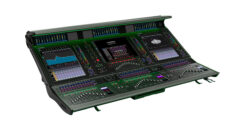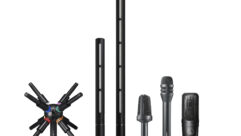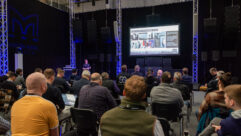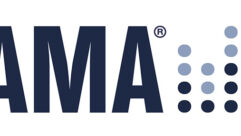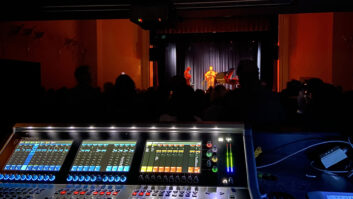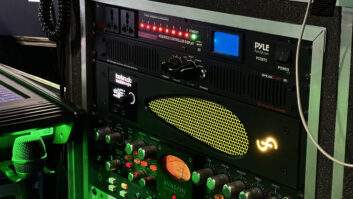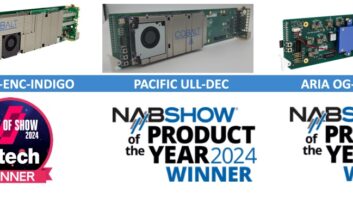Whether the project is live or installed sound, whether it calls for a customized solution or an off-the-shelf option that provides ease of use and no learning curve, there are a number of consoles and processors that fit the bill. We’ve rounded up some of the latest.
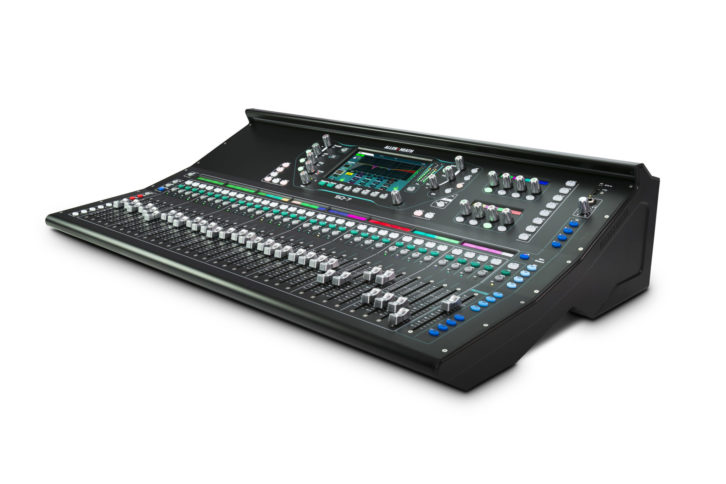 Allen & Heath’s SQ-7, the 33 fader flagship console in its 96kHz SQ series, takes the XCVI 96kHz FPGA engine and adds extended control and I/O in a larger format, featuring 33 faders, 32 onboard preamps, 16 custom soft keys, and 8 user-definable soft rotary controls. SQ-7 is a 48-channel console, compatible with a range of remote I/O expanders, including the portable DX168 96kHz stage boxes. Inputs and mixes can be individually assigned to 192 fader strips across 6 layers, while 16 softkeys and 8 user-assignable soft rotary controls allow the mixer’s workflow to be customized to the needs of each show and operator. Forthcoming Dante, Waves, and SLink audio networking cards further extend the scope for expansion, system integration, FOH/monitor splits and recording.
Allen & Heath’s SQ-7, the 33 fader flagship console in its 96kHz SQ series, takes the XCVI 96kHz FPGA engine and adds extended control and I/O in a larger format, featuring 33 faders, 32 onboard preamps, 16 custom soft keys, and 8 user-definable soft rotary controls. SQ-7 is a 48-channel console, compatible with a range of remote I/O expanders, including the portable DX168 96kHz stage boxes. Inputs and mixes can be individually assigned to 192 fader strips across 6 layers, while 16 softkeys and 8 user-assignable soft rotary controls allow the mixer’s workflow to be customized to the needs of each show and operator. Forthcoming Dante, Waves, and SLink audio networking cards further extend the scope for expansion, system integration, FOH/monitor splits and recording.
 The AMX Alero ALR-AEC-8 is a dedicated microphone mixer for up to eight microphones used for conferencing apps such as Lync or Skype in medium to large meeting rooms. It also supports VTC and audio conferencing systems. A USB audio output enables the Alero ALR-AEC-8 to be a microphone expansion unit for Enzo or PC-Based web conferencing applications, while an onboard web configuration tool allows for simple setup and configuration for users of any experience level, with no PC software required. The active adjustment of audio levels and settings means great audio quality without users having to make manual adjustments. Additionally, acoustic echo cancellation helps eliminate echo feedback during web and audio conferences.
The AMX Alero ALR-AEC-8 is a dedicated microphone mixer for up to eight microphones used for conferencing apps such as Lync or Skype in medium to large meeting rooms. It also supports VTC and audio conferencing systems. A USB audio output enables the Alero ALR-AEC-8 to be a microphone expansion unit for Enzo or PC-Based web conferencing applications, while an onboard web configuration tool allows for simple setup and configuration for users of any experience level, with no PC software required. The active adjustment of audio levels and settings means great audio quality without users having to make manual adjustments. Additionally, acoustic echo cancellation helps eliminate echo feedback during web and audio conferences.
 Ashly Audio’s mXa-1502 Mixer Amp MVP provides four zones of mixing and DSP, plus 2 x 150W of power and programmable mic preamplifiers. The new mXa-1502 also incorporates DSP functions on all input and output channels and can be accessed and controlled via any browser-enabled device as well as the network using intuitive Ashly software. It also provides multi-zone music distribution, paging, sound-masking and automatic mixing for a wide range of environments including house of worship, education, business, and live performance. Its GUI doesn’t require extensive tutorials or workshops to master, allowing both integrators and end users to navigate using any browser-enabled device. Further, troubleshooting and reconfiguring can take place over the network, delivering a reduction in onsite technical support and a quicker return to functionality.
Ashly Audio’s mXa-1502 Mixer Amp MVP provides four zones of mixing and DSP, plus 2 x 150W of power and programmable mic preamplifiers. The new mXa-1502 also incorporates DSP functions on all input and output channels and can be accessed and controlled via any browser-enabled device as well as the network using intuitive Ashly software. It also provides multi-zone music distribution, paging, sound-masking and automatic mixing for a wide range of environments including house of worship, education, business, and live performance. Its GUI doesn’t require extensive tutorials or workshops to master, allowing both integrators and end users to navigate using any browser-enabled device. Further, troubleshooting and reconfiguring can take place over the network, delivering a reduction in onsite technical support and a quicker return to functionality.
 The Audio-Technica ATDM-0604 is a six-channel automatic mixer ideal for meetings, conferences, courtroom proceedings, and other applications involving the use of multiple microphones or other media inputs. AudioTechnica’s SmartMixer technology allows channels to be mixed automatically in gate or gain sharing mode, ensuring consistent, high-quality audio output from all inputs in a setup. Controls and LED indicators on the mixer’s front panel allow users to easily adjust input/output and gain levels; set and recall presets; turn on/off phantom power, low-cut filter, automatic mixing and acoustic echo cancellation; change IP configuration; and more. A full complement of digital signal processing is available for inputs and outputs, including parametric EQ, compressor, limiter, and feedback control. Control and monitoring tools are accessible locally on the front panel or via the Web Remote interface, which allows users to handle the adjustments from a Windows-based PC, Mac, iOS or Android device, plus make additional changes to settings.
The Audio-Technica ATDM-0604 is a six-channel automatic mixer ideal for meetings, conferences, courtroom proceedings, and other applications involving the use of multiple microphones or other media inputs. AudioTechnica’s SmartMixer technology allows channels to be mixed automatically in gate or gain sharing mode, ensuring consistent, high-quality audio output from all inputs in a setup. Controls and LED indicators on the mixer’s front panel allow users to easily adjust input/output and gain levels; set and recall presets; turn on/off phantom power, low-cut filter, automatic mixing and acoustic echo cancellation; change IP configuration; and more. A full complement of digital signal processing is available for inputs and outputs, including parametric EQ, compressor, limiter, and feedback control. Control and monitoring tools are accessible locally on the front panel or via the Web Remote interface, which allows users to handle the adjustments from a Windows-based PC, Mac, iOS or Android device, plus make additional changes to settings.
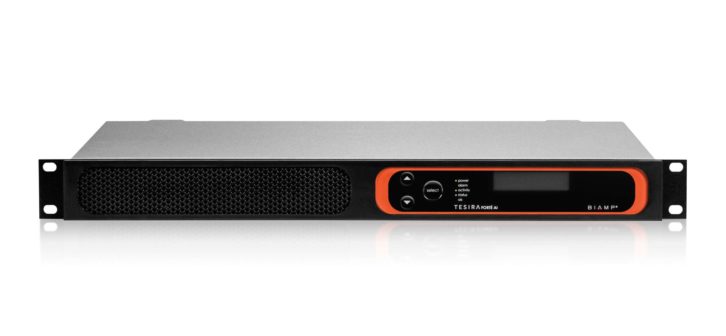 The TesiraFORTÉ DAN audio processors are the collaborative result between Biamp and Shure. Offered in the same four fixed I/O models as the original TesiraFORTÉ family (AI, CI, TI, and VI) with the addition of 32×32 channels of audio via the Dante Brooklyn II module. All models are standard with 12 mic/line inputs, eight line outputs, Ethernet control, RS-232, USB audio with up to eight channels of configurable audio, four general purpose I/Os, and an OLED display. The TesiraFORTÉ DAN VI, TI, and CI models feature Biamp’s AEC technology to eliminate acoustic echoes and feedback for a clear, natural-sounding audio experience. Along with the new dedicated Shure MXA input blocks in the latest Tesira 3.0 software, these new processors deliver seamless interoperability between the most advanced DSP and microphone technologies.
The TesiraFORTÉ DAN audio processors are the collaborative result between Biamp and Shure. Offered in the same four fixed I/O models as the original TesiraFORTÉ family (AI, CI, TI, and VI) with the addition of 32×32 channels of audio via the Dante Brooklyn II module. All models are standard with 12 mic/line inputs, eight line outputs, Ethernet control, RS-232, USB audio with up to eight channels of configurable audio, four general purpose I/Os, and an OLED display. The TesiraFORTÉ DAN VI, TI, and CI models feature Biamp’s AEC technology to eliminate acoustic echoes and feedback for a clear, natural-sounding audio experience. Along with the new dedicated Shure MXA input blocks in the latest Tesira 3.0 software, these new processors deliver seamless interoperability between the most advanced DSP and microphone technologies.
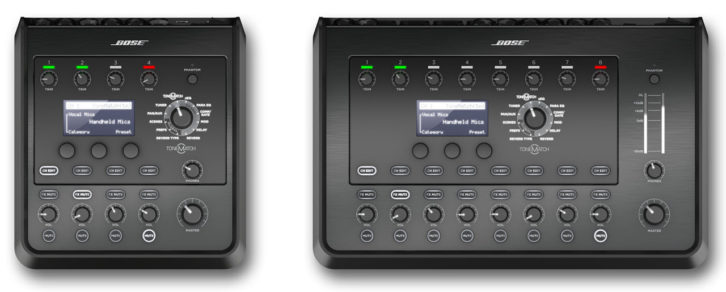 The latest additions to Bose’s ToneMatch audio engine series, the eight-channel T8S ToneMatch mixer and the four-channel T4S ToneMatch mixer, are compact and portable. Their enclosures have a protective, magnetically-coupled cover to protect controls and connectors. A chassis-bottom insert allows the use of standard mounting accessories to keep the mixers in reach during performances. The T8S is intuitive to operate, with illuminated, stage-friendly tactile controls, an easy-to-read display, and scene recall. ToneMatch processing provides presets with the DSP engine, including effects and Bose zEQ equalization. The T4S offers most of the same features as the T8S, but also includes dual ToneMatch links, designed to send digital audio to L1 Model 1S/II systems while receiving power on the same provided ToneMatch cable.
The latest additions to Bose’s ToneMatch audio engine series, the eight-channel T8S ToneMatch mixer and the four-channel T4S ToneMatch mixer, are compact and portable. Their enclosures have a protective, magnetically-coupled cover to protect controls and connectors. A chassis-bottom insert allows the use of standard mounting accessories to keep the mixers in reach during performances. The T8S is intuitive to operate, with illuminated, stage-friendly tactile controls, an easy-to-read display, and scene recall. ToneMatch processing provides presets with the DSP engine, including effects and Bose zEQ equalization. The T4S offers most of the same features as the T8S, but also includes dual ToneMatch links, designed to send digital audio to L1 Model 1S/II systems while receiving power on the same provided ToneMatch cable.
 The ClearOne CONVERGE Pro 2 48VTD includes VoIP, Telco, and Dante interfaces in a single CONVERGE Pro 2 unit. The 48VTD pairs well with ClearOne’s BMA CT and allows integrators to simplify system designs, increasing installation flexibility and reducing costs. The four-input CONVERGE Pro 2 48VTD can also lower costs when paired with our new P-Link-based BMA CT, allowing integrators to bring a low-cost Dante interface to the BMA CT. It functions the same as ClearOne’s existing V and T offerings providing a 10-Watt amplifier, four configurable mic/line audio inputs, and 8 configurable mic/line outputs. Additionally, all models are Avaya, Cisco, and ShoreTel compliant, and support built-in USB audio, and built-in Skype for Business along with interfaces for VoIP, Telco, and Dante. The VTD series works with all existing CONVERGE Pro 2 units and all existing P-Link peripheral products.
The ClearOne CONVERGE Pro 2 48VTD includes VoIP, Telco, and Dante interfaces in a single CONVERGE Pro 2 unit. The 48VTD pairs well with ClearOne’s BMA CT and allows integrators to simplify system designs, increasing installation flexibility and reducing costs. The four-input CONVERGE Pro 2 48VTD can also lower costs when paired with our new P-Link-based BMA CT, allowing integrators to bring a low-cost Dante interface to the BMA CT. It functions the same as ClearOne’s existing V and T offerings providing a 10-Watt amplifier, four configurable mic/line audio inputs, and 8 configurable mic/line outputs. Additionally, all models are Avaya, Cisco, and ShoreTel compliant, and support built-in USB audio, and built-in Skype for Business along with interfaces for VoIP, Telco, and Dante. The VTD series works with all existing CONVERGE Pro 2 units and all existing P-Link peripheral products.
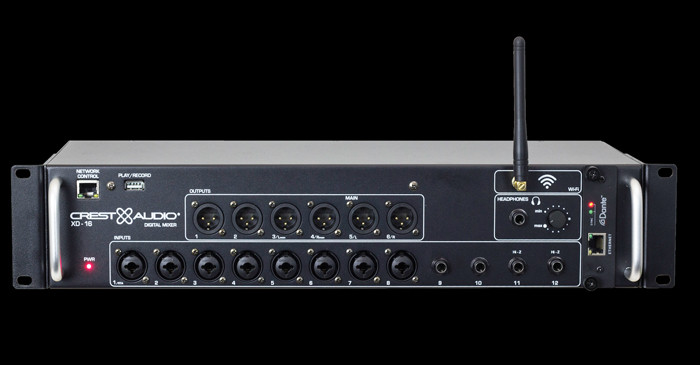 The XD-16 and XD-28 digital mixers from Crest Audio are small format, 2U rackmount mixers available in either 16- or 28-channel frames. XD Series digital mixers offer optional Dante networking as well as realtime remote control and monitoring from any Android, Windows, or iOS device. The range of configurations available enables use as a simple FoH mixer, a monitor mixer, a personal monitor mixer, or a combination of all three. An integrated WiFi module enables real-time control and monitoring of the mixer processing functions, either by acting as a WiFi router for direct connection of up to four external devices for remote control, or alternatively by connecting to an external WiFi network. The optional 4×4 Dante network module allows up to eight channels (4-in/4-out) of audio streaming over a Dante network, extends the physical inputs of the XD-16/XD-28 by four aux channels, and also adds four outputs. Control is provided via the Dante Controller application.
The XD-16 and XD-28 digital mixers from Crest Audio are small format, 2U rackmount mixers available in either 16- or 28-channel frames. XD Series digital mixers offer optional Dante networking as well as realtime remote control and monitoring from any Android, Windows, or iOS device. The range of configurations available enables use as a simple FoH mixer, a monitor mixer, a personal monitor mixer, or a combination of all three. An integrated WiFi module enables real-time control and monitoring of the mixer processing functions, either by acting as a WiFi router for direct connection of up to four external devices for remote control, or alternatively by connecting to an external WiFi network. The optional 4×4 Dante network module allows up to eight channels (4-in/4-out) of audio streaming over a Dante network, extends the physical inputs of the XD-16/XD-28 by four aux channels, and also adds four outputs. Control is provided via the Dante Controller application.
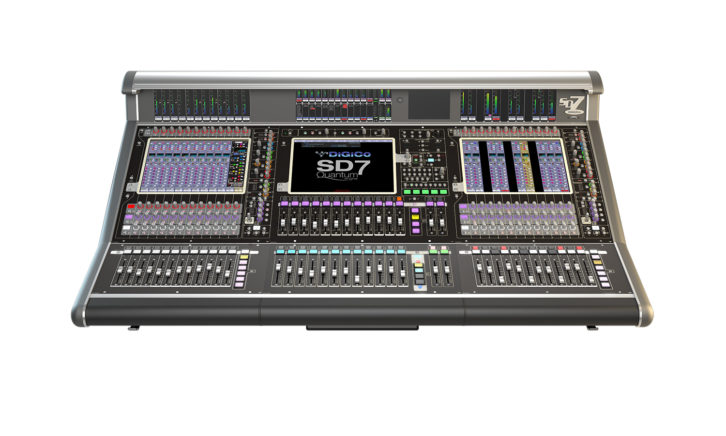 The DiGiCo SD7 Quantum expands the company’s SD7 to more than 640 channels of processing in 96kHz operation that can be connected in the outside world to approaching 3000 potential I/Os. The engine is also equipped with eight newly assignable MADI connections and two DMI slots (DiGiCo Multi-Channel Interface) for AoIP and other connectivity options from the complete family of DMI card options. There are other enhancements, too, including Nodal Processing and True Solo. Nodal Processing means that processing can be applied to any node on the auxiliary section of the console, allowing engineers to send unique processing on each aux send from a single, or multiple, channels. The True Solo system allows the operator’s monitoring system to solo almost any section of the console, and determine how that source is being processed and heard. This saves time and speeds up the process of managing the potentially daunting number of channels and busses available to the user.
The DiGiCo SD7 Quantum expands the company’s SD7 to more than 640 channels of processing in 96kHz operation that can be connected in the outside world to approaching 3000 potential I/Os. The engine is also equipped with eight newly assignable MADI connections and two DMI slots (DiGiCo Multi-Channel Interface) for AoIP and other connectivity options from the complete family of DMI card options. There are other enhancements, too, including Nodal Processing and True Solo. Nodal Processing means that processing can be applied to any node on the auxiliary section of the console, allowing engineers to send unique processing on each aux send from a single, or multiple, channels. The True Solo system allows the operator’s monitoring system to solo almost any section of the console, and determine how that source is being processed and heard. This saves time and speeds up the process of managing the potentially daunting number of channels and busses available to the user.
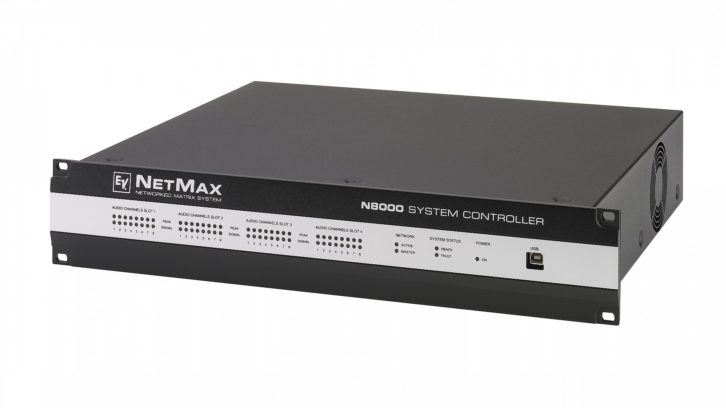 The Electro-Voice N8000 NetMax 300 MIPS digital matrix controller delivers full IRIS-Net supervision, control, and scheduling along with up to 32 input channels, extensive DSP, and CobraNet audio and control connections. It offers support for ethernet, RS-232, USB, and CAN. Dante audio networking options are also available. Four slots with 8-channel audio modules form the foundation for flexible customization, and each slot can house input or output cards. It includes internal 48-bit processing, and the auto-compiling DSP engine has ultra-low fixed latency. One time or regularly scheduled events can be arranged and reactions to certain events or system states can be configured. Any system problems can be detected automatically and can be displayed on the PC screen or transmitted to external sites.
The Electro-Voice N8000 NetMax 300 MIPS digital matrix controller delivers full IRIS-Net supervision, control, and scheduling along with up to 32 input channels, extensive DSP, and CobraNet audio and control connections. It offers support for ethernet, RS-232, USB, and CAN. Dante audio networking options are also available. Four slots with 8-channel audio modules form the foundation for flexible customization, and each slot can house input or output cards. It includes internal 48-bit processing, and the auto-compiling DSP engine has ultra-low fixed latency. One time or regularly scheduled events can be arranged and reactions to certain events or system states can be configured. Any system problems can be detected automatically and can be displayed on the PC screen or transmitted to external sites.
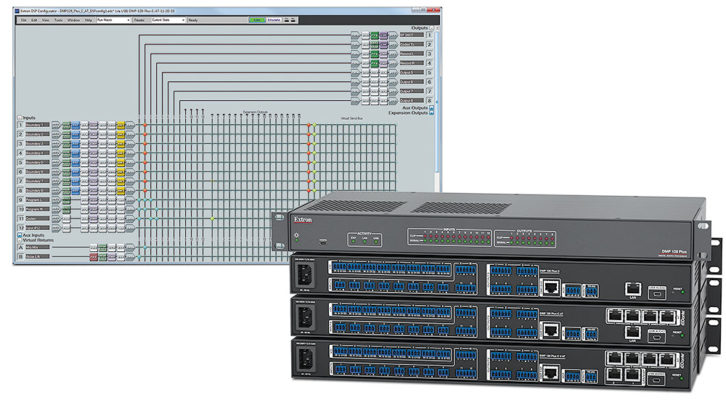 Extron has released firmware version 1.02 for the DMP 128 Plus digital matrix processors. With this free firmware update, the four DMP 128 Plus C models support up to 12 independent channels of high performance AEC, up from 8 channels, with no hardware changes. The three DMP 128 Plus AT models now also support Dante Domain Manager, network management software, from Audinate. DDM enables user authentication, role-based security, and seamless expansion of Dante systems over any network infrastructure. This firmware update adds compatibility with the VoIP MS cloud-based VoIP system for the DMP 128 Plus V models, continuing our commitment to the widest possible VoIP compatibility. Finally, the ability to convert project files between DMP 128 Plus types has been added with this firmware and DSP Configurator Software version 2.20.
Extron has released firmware version 1.02 for the DMP 128 Plus digital matrix processors. With this free firmware update, the four DMP 128 Plus C models support up to 12 independent channels of high performance AEC, up from 8 channels, with no hardware changes. The three DMP 128 Plus AT models now also support Dante Domain Manager, network management software, from Audinate. DDM enables user authentication, role-based security, and seamless expansion of Dante systems over any network infrastructure. This firmware update adds compatibility with the VoIP MS cloud-based VoIP system for the DMP 128 Plus V models, continuing our commitment to the widest possible VoIP compatibility. Finally, the ability to convert project files between DMP 128 Plus types has been added with this firmware and DSP Configurator Software version 2.20.
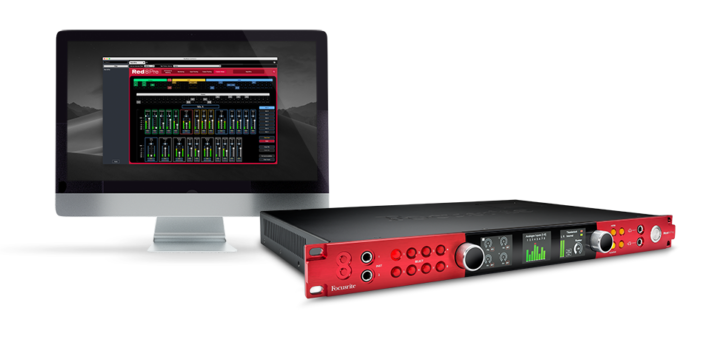 Focusrite has released RedNet Control 2.3, a free update that unifies RedNet Control with configuration, status monitoring, metering, and extended operational control of the Red 4Pre, Red 8Pre, and Red 16Line, Focusrite’s range of audio interfaces offering up to 64-in/64-out Thunderbolt I/O with Pro Tools HD and Dante network audio connectivity. Focusrite RedNet Control’s “Device View” features a graphical representation of each device on the local network, giving critical feedback such as signal metering, clock status, power supply state, and primary/secondary network connection state. RedNet Control is customizable, which allows for several users on the same network to have completely different views. RedNet Control now also provides parameter control, which includes clock source selection, sample rate converter configuration, and reference level setup.
Focusrite has released RedNet Control 2.3, a free update that unifies RedNet Control with configuration, status monitoring, metering, and extended operational control of the Red 4Pre, Red 8Pre, and Red 16Line, Focusrite’s range of audio interfaces offering up to 64-in/64-out Thunderbolt I/O with Pro Tools HD and Dante network audio connectivity. Focusrite RedNet Control’s “Device View” features a graphical representation of each device on the local network, giving critical feedback such as signal metering, clock status, power supply state, and primary/secondary network connection state. RedNet Control is customizable, which allows for several users on the same network to have completely different views. RedNet Control now also provides parameter control, which includes clock source selection, sample rate converter configuration, and reference level setup.
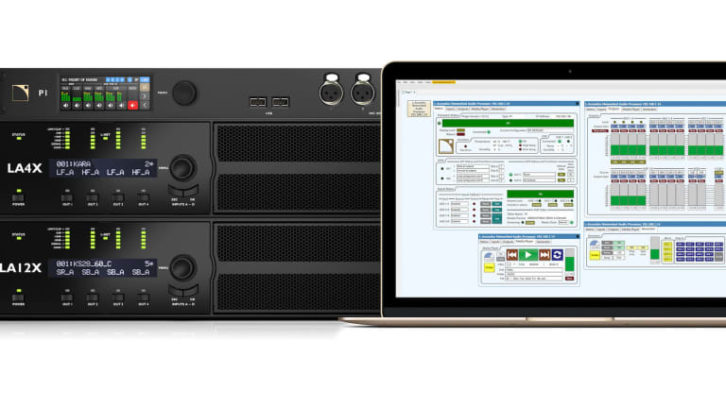 The L-Acoustics P1 processor can now be integrated with the Q-SYS Platform from QSC, allowing users to easily control and monitor P1 through Q-SYS. System designers can architect high-performing and fully scalable AV environments using the familiar Q-SYS Designer Software and native user control interface. The L-Acoustics P1 plug-in for the Q-SYS Platform, as well as the LA4X and LA12X Q-SYS plug-ins, can be found on the L-Acoustics website on the corresponding product page.
The L-Acoustics P1 processor can now be integrated with the Q-SYS Platform from QSC, allowing users to easily control and monitor P1 through Q-SYS. System designers can architect high-performing and fully scalable AV environments using the familiar Q-SYS Designer Software and native user control interface. The L-Acoustics P1 plug-in for the Q-SYS Platform, as well as the LA4X and LA12X Q-SYS plug-ins, can be found on the L-Acoustics website on the corresponding product page.
 Lectrosonics had versatility in mind when it developed the Aspen SPN2412, with its 24 inputs and 12 outputs, which can be expanded to many more. The Proportional Gain Algorithm allows it to work seamlessly with other sound gear, while data, audio, and control signals are carried through a single Cat-6 cable. Setup is aided by automatic master/slave detection and its automatic mixing parameters and presets are extensive including multizone mix minus configuration. The Phantom Mix mode lets the mixing come from multiple zones and are fed back into only those zones that are selected for the feed. And with TCP/ IP addressability for control through ethernet, it can be part of your network.
Lectrosonics had versatility in mind when it developed the Aspen SPN2412, with its 24 inputs and 12 outputs, which can be expanded to many more. The Proportional Gain Algorithm allows it to work seamlessly with other sound gear, while data, audio, and control signals are carried through a single Cat-6 cable. Setup is aided by automatic master/slave detection and its automatic mixing parameters and presets are extensive including multizone mix minus configuration. The Phantom Mix mode lets the mixing come from multiple zones and are fed back into only those zones that are selected for the feed. And with TCP/ IP addressability for control through ethernet, it can be part of your network.
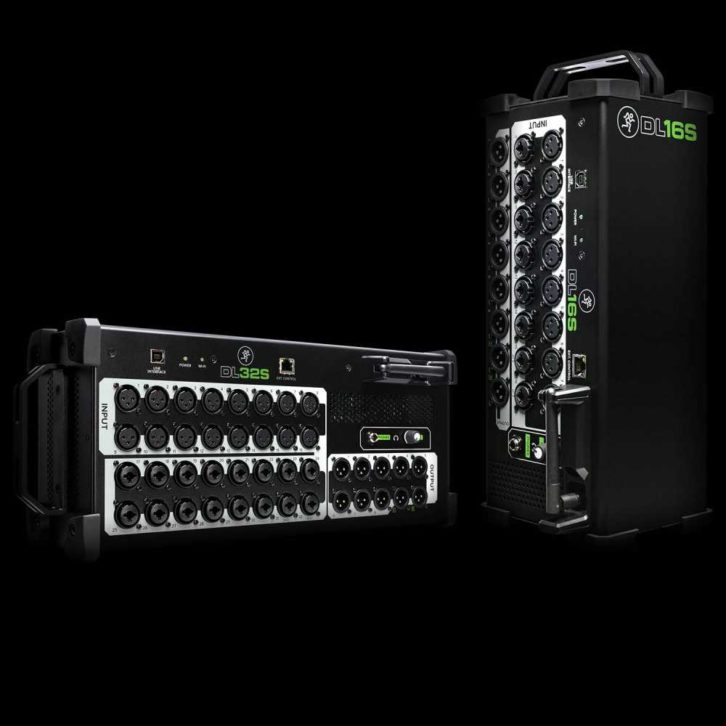 Mackie’s 16-channel DL16S and 32-channel DL32S wireless digital live sound mixers with built-in WiFi for multi-platform control deliver the proven performance and intuitive control that the DL Series is known for in an affordable, tough stagebox form factor. Both models make it easier to get mixing right out of the box with built-in WiFi networking and multi-platform support on the industry-leading Master Fader control app. They include Onyx+ mic preamps, fully loaded DSP on each input and output, plus four FX processors. They also include a new suite of FX like chorus, flanger, rotary, auto-filter, and more. All these FX are easily accessed via a refreshed interface that allows more freedom for choosing the FX desired and view of what is currently selected.
Mackie’s 16-channel DL16S and 32-channel DL32S wireless digital live sound mixers with built-in WiFi for multi-platform control deliver the proven performance and intuitive control that the DL Series is known for in an affordable, tough stagebox form factor. Both models make it easier to get mixing right out of the box with built-in WiFi networking and multi-platform support on the industry-leading Master Fader control app. They include Onyx+ mic preamps, fully loaded DSP on each input and output, plus four FX processors. They also include a new suite of FX like chorus, flanger, rotary, auto-filter, and more. All these FX are easily accessed via a refreshed interface that allows more freedom for choosing the FX desired and view of what is currently selected.
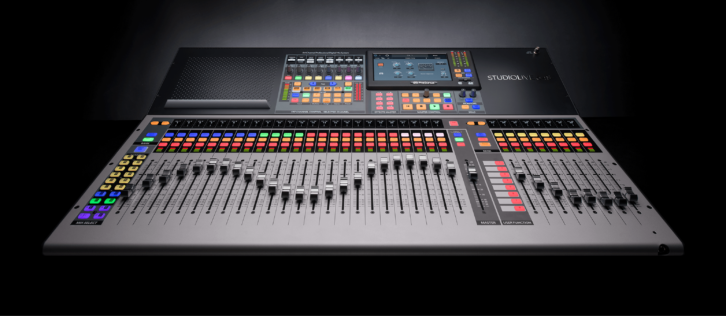 With the StudioLive 64S, PreSonus brings the power of a large production console to small-format digital mixing, with 76 mixing channels, 43 buses, and 526 simultaneous effects thanks to the all new quad-core FLEX DSP engine. StudioLive 64S mixers feature an independent main Mono/Center bus; each channel has a dedicated level control and a Center Divergence control that allows users to control the pan placement in their LCR mix. Powered by the PreSonus FLEX DSP Engine, it features state-space modeled Fat Channel plug-in processing on every input and bus; up to 32 FlexMix buses that can be individually configured as Aux, Matrix, or Subgroup buses; and flexible digital patching. It delivers 128-channel (64×64) USB recording, plus multitrack SD recording and extensive 128-channel AVB networking.
With the StudioLive 64S, PreSonus brings the power of a large production console to small-format digital mixing, with 76 mixing channels, 43 buses, and 526 simultaneous effects thanks to the all new quad-core FLEX DSP engine. StudioLive 64S mixers feature an independent main Mono/Center bus; each channel has a dedicated level control and a Center Divergence control that allows users to control the pan placement in their LCR mix. Powered by the PreSonus FLEX DSP Engine, it features state-space modeled Fat Channel plug-in processing on every input and bus; up to 32 FlexMix buses that can be individually configured as Aux, Matrix, or Subgroup buses; and flexible digital patching. It delivers 128-channel (64×64) USB recording, plus multitrack SD recording and extensive 128-channel AVB networking.
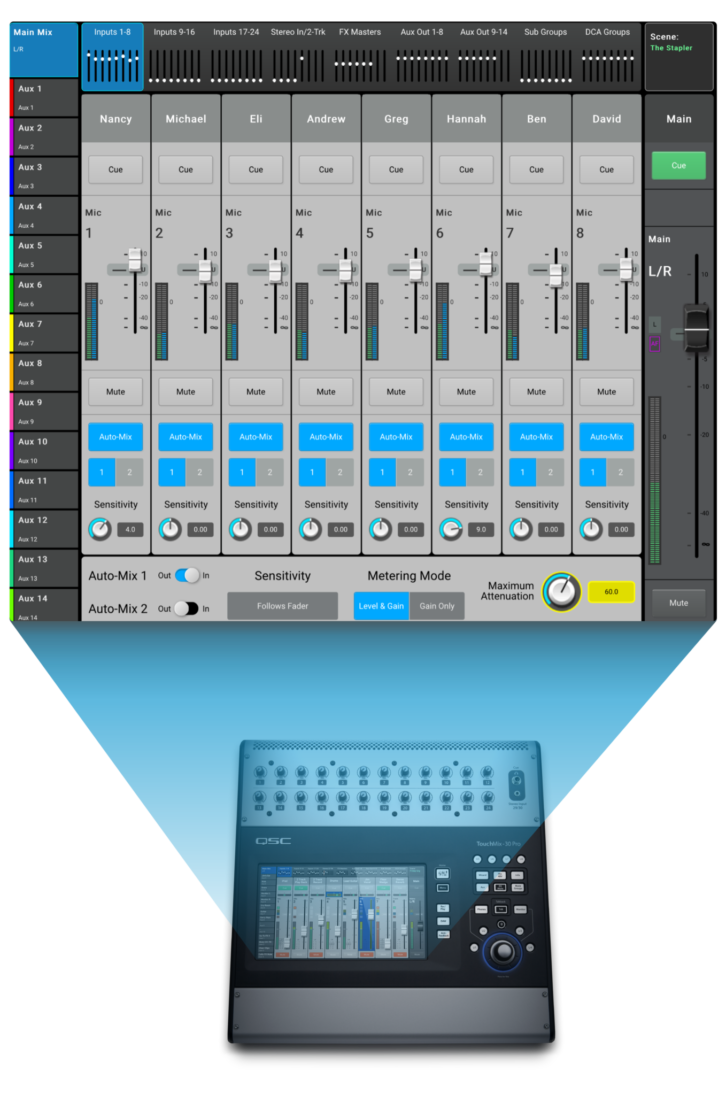 QSC has added Automatic Microphone Mixing (Auto Mix) to its TouchMix-30 Pro digital mixer. Providing two independent processors available to all of the mixer’s 24 Mic/Line inputs, the easy-to-configure and use Auto Mix function delivers advanced gain sharing capabilities to audio professionals for applications such as conferences, presentations, panel discussions, and theatrical sound reinforcement. The TouchMix-30 Pro Automatic Microphone Mixing feature is a component of the latest firmware upgrade, Version 1.3, available as a free download at QSC.com.
QSC has added Automatic Microphone Mixing (Auto Mix) to its TouchMix-30 Pro digital mixer. Providing two independent processors available to all of the mixer’s 24 Mic/Line inputs, the easy-to-configure and use Auto Mix function delivers advanced gain sharing capabilities to audio professionals for applications such as conferences, presentations, panel discussions, and theatrical sound reinforcement. The TouchMix-30 Pro Automatic Microphone Mixing feature is a component of the latest firmware upgrade, Version 1.3, available as a free download at QSC.com.
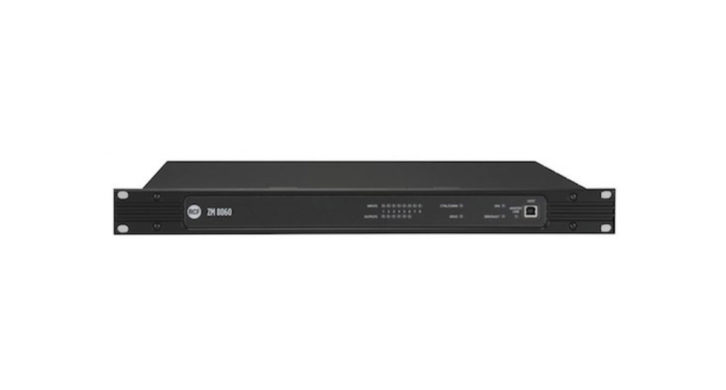 The RCF MZ8060 is a versatile 8×6 digital audio matrix mixer built on the foundation of RCF’s RDNet DSP platform. RDNet is a proprietary protocol for RCF loudspeaker products that provides dedicated networking software that makes is possible to control and monitor all system components and parameters. The DSP allows for configurable system programming including room combining, automatic level control, along with all audio input and output criteria including EQs, gates, compressors, limiters, delays, priorities, and levels. The MX8060 features eight universal mic/line inputs with six balanced outputs along with 10 programmable logic inputs and six programmable logic outputs. It features eights universal mic/line inputs with 48V phantom power and full audio processing, six hi-level routable balanced outputs with full audio processing, 10 programmable logic inputs (GPI), and six programmable logic outputs (GPO).
The RCF MZ8060 is a versatile 8×6 digital audio matrix mixer built on the foundation of RCF’s RDNet DSP platform. RDNet is a proprietary protocol for RCF loudspeaker products that provides dedicated networking software that makes is possible to control and monitor all system components and parameters. The DSP allows for configurable system programming including room combining, automatic level control, along with all audio input and output criteria including EQs, gates, compressors, limiters, delays, priorities, and levels. The MX8060 features eight universal mic/line inputs with six balanced outputs along with 10 programmable logic inputs and six programmable logic outputs. It features eights universal mic/line inputs with 48V phantom power and full audio processing, six hi-level routable balanced outputs with full audio processing, 10 programmable logic inputs (GPI), and six programmable logic outputs (GPO).
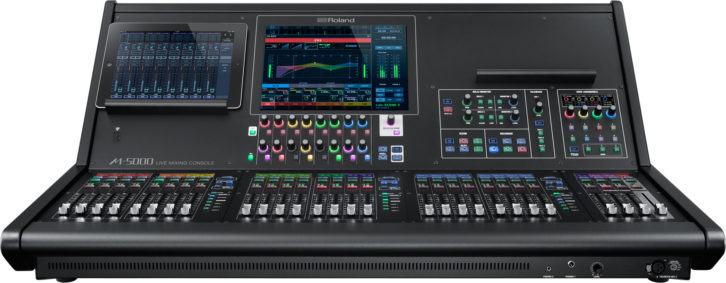 The M-5000 Series mixing consoles from Roland apply its OHRCA (Open High Resolution Configurable Architecture) to provide 128 freely definable audio paths. The mixers have expansion modules for Dante, MADI, Waves Soundgrid, REAC, XI-SDI, XI- SFP, and XI-DVI. Its patchbays can accommodate hundreds of input/output channels enabling any input to be routed to a range of outputs without using a mixing channel. The M-5000 has 24 plus 4 faders while the slightly smaller M-5000C uses 16 plus 4 faders. The operation is focused on a bright 12in. touchscreen with 16 encoders having rings that change color according to their assigned functions.
The M-5000 Series mixing consoles from Roland apply its OHRCA (Open High Resolution Configurable Architecture) to provide 128 freely definable audio paths. The mixers have expansion modules for Dante, MADI, Waves Soundgrid, REAC, XI-SDI, XI- SFP, and XI-DVI. Its patchbays can accommodate hundreds of input/output channels enabling any input to be routed to a range of outputs without using a mixing channel. The M-5000 has 24 plus 4 faders while the slightly smaller M-5000C uses 16 plus 4 faders. The operation is focused on a bright 12in. touchscreen with 16 encoders having rings that change color according to their assigned functions.
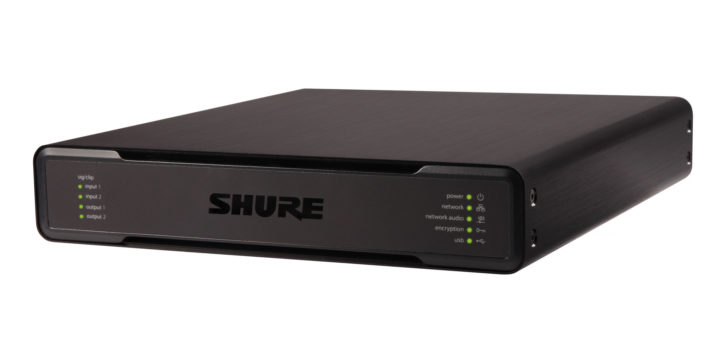 The Shure IntelliMix P300 conferencing connects up to 10 Dante audio inputs, two analog inputs, a USB soft codec, and mobile device. Each input channel can be auto-mixed and provides acoustic echo cancellation, noise reduction, automatic gain control, matrix mixing, delay, compressor, and PEQ. An additional 3.5mm connection enables attendees to join by tablet or phone, and all this fits into a half-rack space package. It connects to room systems through two input and two output terminal blocks while its ethernet connection can use PoE to eliminate a separate power supply. Additionally, a predefined matrix and presets can simplify the setup process.
The Shure IntelliMix P300 conferencing connects up to 10 Dante audio inputs, two analog inputs, a USB soft codec, and mobile device. Each input channel can be auto-mixed and provides acoustic echo cancellation, noise reduction, automatic gain control, matrix mixing, delay, compressor, and PEQ. An additional 3.5mm connection enables attendees to join by tablet or phone, and all this fits into a half-rack space package. It connects to room systems through two input and two output terminal blocks while its ethernet connection can use PoE to eliminate a separate power supply. Additionally, a predefined matrix and presets can simplify the setup process.
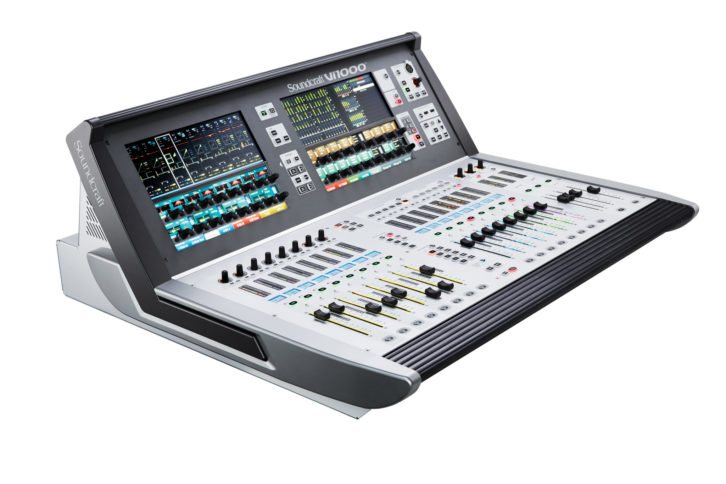
Soundcraft by HARMAN offers the Vi1000 digital mixing console, a 34in. x 32in. compliment to its two larger siblings, the Vi2000 and 3000. The Vi1000 employs Soundcraft’s Vistonics II channel strip user interface, as well as SpiderCore, a built-in DSP and I/O engine based on STUDER technology, offering 40-bit floating point processing. The Vi1000 features an additional remote-control surface for any of the larger consoles in the range, using their Mirroring feature. The Vi1000 comes with rear panel local I/O featuring 16 HQ mic/line inputs, 16 line outputs, and two 64-channel expansion slots that allow up to two MADI-based Stageboxes to be connected, or alternatively the slots provide access to an extensive range of D21m I/O option cards, that address all industry standard audio formats. Four channels of AES/EBU I/O plus USB and MIDI connections complete the back panel. The total I/O count of the console is 212 in x 212 out.
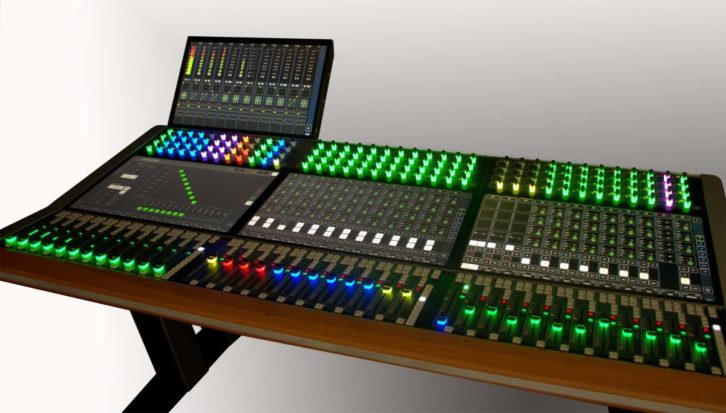 Stage Tec’s IP-based mixing console AVATUS is a theatre console with detachable screens. In many theatres, due to structural conditions, control rooms are built such that the sound engineers cannot see over their mixing console to the stage. AVATUS offers a solution to this problem. The theatre version of AVATUS is designed so that the upper screens are removable. Since the IP console is connected via standard TCP/IP interfaces, each module has its own IP address. This enables the screens to be installed anywhere within the NEXUS network. AVATUS IPbased connections offer new possibilities for development of infrastructures. The AVATUS audio console does not have a center section and will consist of only three different modules. The console will be available in sizes between 12 and 96 faders.
Stage Tec’s IP-based mixing console AVATUS is a theatre console with detachable screens. In many theatres, due to structural conditions, control rooms are built such that the sound engineers cannot see over their mixing console to the stage. AVATUS offers a solution to this problem. The theatre version of AVATUS is designed so that the upper screens are removable. Since the IP console is connected via standard TCP/IP interfaces, each module has its own IP address. This enables the screens to be installed anywhere within the NEXUS network. AVATUS IPbased connections offer new possibilities for development of infrastructures. The AVATUS audio console does not have a center section and will consist of only three different modules. The console will be available in sizes between 12 and 96 faders.
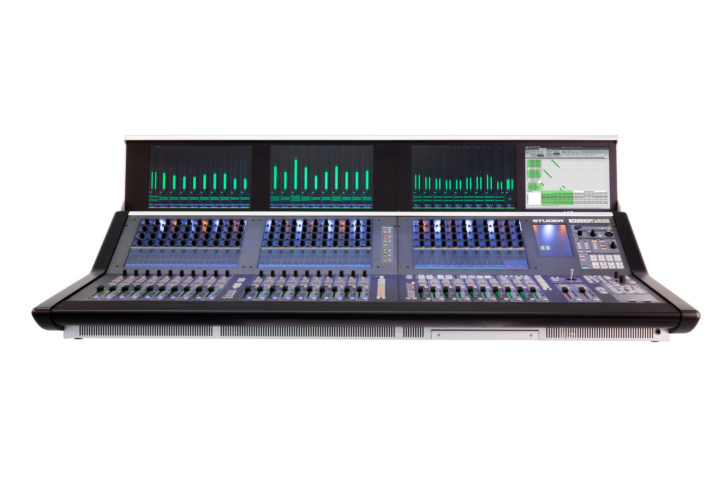 Harman has introduced the Studer Vista 5 Black Edition console, a “budget friendly” addition to its Vista 5 line. The desk is designed to be a scalable mixing system with full processing redundancy. Based on the Vista 5 M3 mixing console, the new Vista 5 Black Edition features the Studer Infinity Core processing engine. The Studer Vista 5 Black Edition is available in 22-, 32-, and 44-fader sizes, and supports an optional TFT meter bridge. The console’s features include Studer’s Vistronics interface and FaderGlow technology, as well as the Infinity Core’s advanced capabilities such as Dynamic EQ plug-ins and full Core redundancy with up to 1,000 MEQs (Mono Equivalent Channels). The Vista 5 Black Edition supports any of Studer’s range of Infinity Core products, as well as the Studer Infinity Core Commercial off the Shelf (COTS) solution. This IT-based solution allows customers to run Studer’s real-time audio processing on their own server hardware by adding a standard PCIe Infinity CoreLink card.
Harman has introduced the Studer Vista 5 Black Edition console, a “budget friendly” addition to its Vista 5 line. The desk is designed to be a scalable mixing system with full processing redundancy. Based on the Vista 5 M3 mixing console, the new Vista 5 Black Edition features the Studer Infinity Core processing engine. The Studer Vista 5 Black Edition is available in 22-, 32-, and 44-fader sizes, and supports an optional TFT meter bridge. The console’s features include Studer’s Vistronics interface and FaderGlow technology, as well as the Infinity Core’s advanced capabilities such as Dynamic EQ plug-ins and full Core redundancy with up to 1,000 MEQs (Mono Equivalent Channels). The Vista 5 Black Edition supports any of Studer’s range of Infinity Core products, as well as the Studer Infinity Core Commercial off the Shelf (COTS) solution. This IT-based solution allows customers to run Studer’s real-time audio processing on their own server hardware by adding a standard PCIe Infinity CoreLink card.
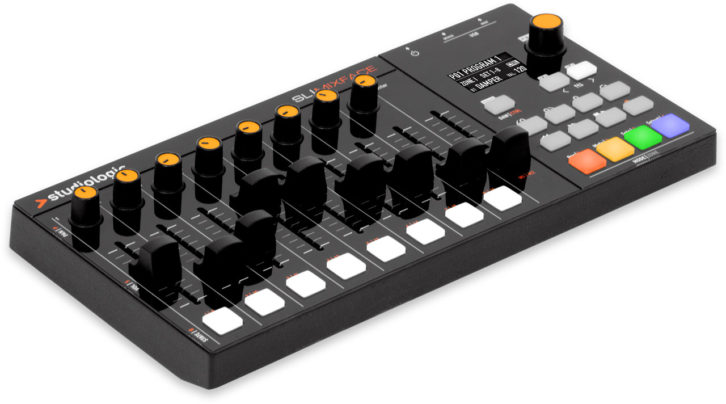 The Studiologic SL MIXFACE is a complete MIDI and DAW Controller device, fully programmable for software and hardware instruments. Designed for mobility, the unit can be battery powered or bus-powered via USB. The SL MIXFACE is able to host any compatible keyboard to transform it into a full four-zone MIDI controller and its connectivity ports enable it to communicate with the computer and other devices by using Bluetooth and USB simultaneously. The surface of the SL MIXFACE features nine faders, eight tracks, and one master, with dedicated, per-track knobs and buttons. The usability of the controller is further enhanced by the DAW/ CTRL button, which allows users to switch the control from the DAW environment to their instrument and vice versa, all reflected on the onboard OLED screen.
The Studiologic SL MIXFACE is a complete MIDI and DAW Controller device, fully programmable for software and hardware instruments. Designed for mobility, the unit can be battery powered or bus-powered via USB. The SL MIXFACE is able to host any compatible keyboard to transform it into a full four-zone MIDI controller and its connectivity ports enable it to communicate with the computer and other devices by using Bluetooth and USB simultaneously. The surface of the SL MIXFACE features nine faders, eight tracks, and one master, with dedicated, per-track knobs and buttons. The usability of the controller is further enhanced by the DAW/ CTRL button, which allows users to switch the control from the DAW environment to their instrument and vice versa, all reflected on the onboard OLED screen.
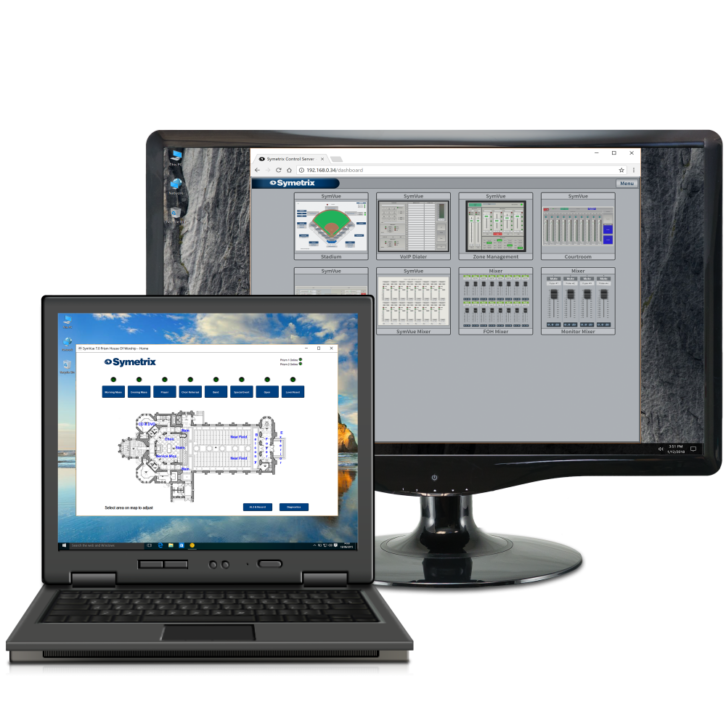 The Symetrix SymVue software, for its Control Server hardware, is a server-based application designed to control Symetrix DSPs. SymVue enables custom GUIs authored using Symetrix’ Composer running on the Symetrix Control Server hardware. Application-specific control screens can be designed and tested in minutes, without writing any code. With SymVue deployed on Symetrix Control Server hardware, Symetrix DSPs can respond to commands from any browser-enabled device — laptops, desktops, tablets, and mobile phones. SymVue’s WYSIWYG designs render in all popular web browsers and adapt to screens of different sizes, resolutions, and orientations. Parameter changes remain in sync across all networked devices including Composer, ARC Wall Panels and ARC-WEB, third-party controllers, and SymVue clients on Windows PCs.
The Symetrix SymVue software, for its Control Server hardware, is a server-based application designed to control Symetrix DSPs. SymVue enables custom GUIs authored using Symetrix’ Composer running on the Symetrix Control Server hardware. Application-specific control screens can be designed and tested in minutes, without writing any code. With SymVue deployed on Symetrix Control Server hardware, Symetrix DSPs can respond to commands from any browser-enabled device — laptops, desktops, tablets, and mobile phones. SymVue’s WYSIWYG designs render in all popular web browsers and adapt to screens of different sizes, resolutions, and orientations. Parameter changes remain in sync across all networked devices including Composer, ARC Wall Panels and ARC-WEB, third-party controllers, and SymVue clients on Windows PCs.
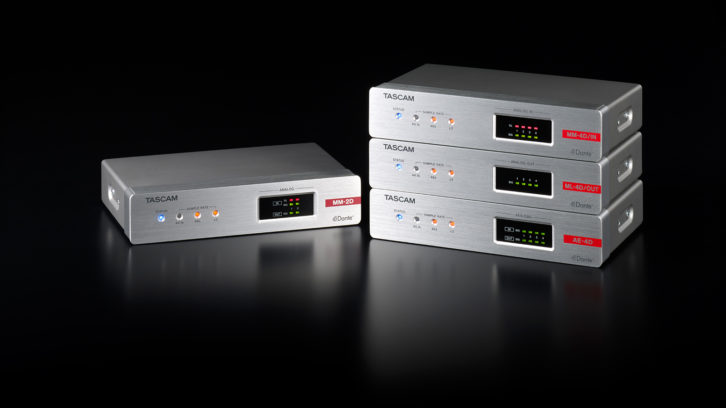 TASCAM’s Dante Compact Processor series comprises seven half-rack Dante audio converters featuring onboard digital matrix mixers with signal processing. These Dante-enabled input/output endpoints deliver up to 24-bit, 96 kHz audio conversion. Dante Compact Processors can be freely combined to create custom systems and are easily installed under desks or on walls with the included surface rack-mount angles or rack-mounted with the optional AK-RS1 rack shelf. All models offer the flexible routing of Audinate’s Dante controller, and are compatible with Dante AES67 mode and Dante Domain Manager. They offer remote control via GPI, Dante, and either of two free TASCAM control software applications, one for integrators and one for end users.
TASCAM’s Dante Compact Processor series comprises seven half-rack Dante audio converters featuring onboard digital matrix mixers with signal processing. These Dante-enabled input/output endpoints deliver up to 24-bit, 96 kHz audio conversion. Dante Compact Processors can be freely combined to create custom systems and are easily installed under desks or on walls with the included surface rack-mount angles or rack-mounted with the optional AK-RS1 rack shelf. All models offer the flexible routing of Audinate’s Dante controller, and are compatible with Dante AES67 mode and Dante Domain Manager. They offer remote control via GPI, Dante, and either of two free TASCAM control software applications, one for integrators and one for end users.
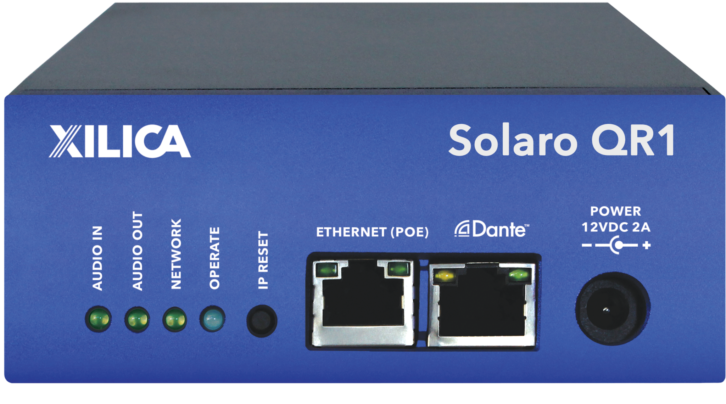 The Xilica Solaro QR1 is a quarter-rack Linux-based DSP processor has eight modular card slots that accept 2-channel audio input and output cards and 4-channel GPIO cards selectable as input or output. The ability to use any card type, in any combination, in any card slot maximizes I/O flexibility, and allows designers to specifically customize I/O without waste. A 4×4 Dante card is built-in. Supported by Xilica’s dragand-drop Designer, it is compatible with various Xilica control interfaces as well as any third-party control system. External power supply included; also PoE. Optional AEC mic inputs up to 8-channels@250ms and 16channels@100ms.
The Xilica Solaro QR1 is a quarter-rack Linux-based DSP processor has eight modular card slots that accept 2-channel audio input and output cards and 4-channel GPIO cards selectable as input or output. The ability to use any card type, in any combination, in any card slot maximizes I/O flexibility, and allows designers to specifically customize I/O without waste. A 4×4 Dante card is built-in. Supported by Xilica’s dragand-drop Designer, it is compatible with various Xilica control interfaces as well as any third-party control system. External power supply included; also PoE. Optional AEC mic inputs up to 8-channels@250ms and 16channels@100ms.
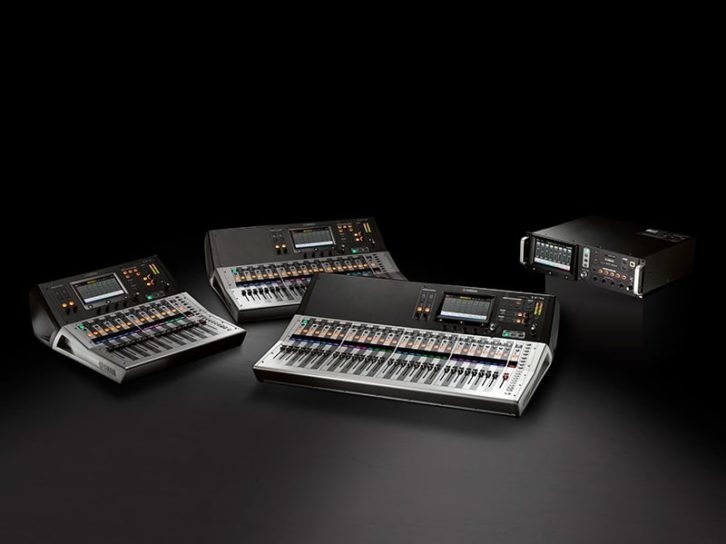 The Yamaha TF Series Digital Mixers with touch-panel operation gain enhanced control and versatility with firmware update version 4.0. Firmware update V4.0 adds a Selected Channel View that provides access to the main parameters for the currently selected input channel in a single display. Combined with the mixer’s Touch & Turn Knob, this new view provides even more intuitive, efficient operation. V4.0 also adds a scene fade time function that offers new flexibility for scene management, particularly in theatrical applications. Support for DZR-D and DXSXLF-D Series speakers has been expanded with speaker amp mute control directly from the mixer display.
The Yamaha TF Series Digital Mixers with touch-panel operation gain enhanced control and versatility with firmware update version 4.0. Firmware update V4.0 adds a Selected Channel View that provides access to the main parameters for the currently selected input channel in a single display. Combined with the mixer’s Touch & Turn Knob, this new view provides even more intuitive, efficient operation. V4.0 also adds a scene fade time function that offers new flexibility for scene management, particularly in theatrical applications. Support for DZR-D and DXSXLF-D Series speakers has been expanded with speaker amp mute control directly from the mixer display.


